Applying Scrum in an Online Physics II Undergraduate Course: Effect on Student Progression and Soft Skills Development
Abstract
1. Introduction
- Daily Scrum meetings did not occur every working day.
- Unclear presentation of the construction of the Product Backlog.
- Sprint Retrospect meetings were not held.
- Delivery of Increments between the Sprints and not in the Sprint Review.
- Unclear references to the Sprint Planning meeting.
- Extra evaluation and planning processes were added apart from those described in the framework.
- Duties and roles were intermingled.
2. Materials and Methods
2.1. Theoretical Background
2.1.1. Scrum Framework Pillars and Values
2.1.2. The Three Roles
2.1.3. Scrum Events
2.1.4. Scrum Artifacts
2.2. Methodology
2.2.1. The Roles of Product Owner and Scrum Master
2.2.2. The Role of Developers
2.2.3. The Final Product
2.2.4. The Product Backlog
2.2.5. The Sprint Backlog
2.2.6. The Increments
2.2.7. The Event of Sprint Planning Meeting
2.2.8. The Event of Sprint
2.2.9. The Event of Daily Scrum Meeting
2.2.10. The Event of Sprint Review Meeting
2.2.11. The Event of Sprint Retrospect Meeting
3. Results
4. Discussion
5. Conclusions
Author Contributions
Funding
Informed Consent Statement
Conflicts of Interest
References
- www.planview.com. Available online: https://www.planview.com/resources/guide/agile-methodologies-a-beginners-guide/history-of-agile/ (accessed on 11 November 2022).
- Manifesto for Agile Software Development. Available online: https://agilemanifesto.org/ (accessed on 11 November 2022).
- Agile Alliance. Available online: https://www.agilealliance.org/agile101/subway-map-to-agile-practices/ (accessed on 11 November 2022).
- The Scrum Guide-The Definitive Guide to Scrum: The Rules of the Game. Available online: https://scrumguides.org/index.html (accessed on 11 November 2022).
- Moyo, E.; Hagmann, J. Facilitating Competence Development to Put Learning Process Approaches into Practice in Rural Extension; FAO: Rome, Italy, 2000; pp. 143–157. ISSN 0251-1495. [Google Scholar]
- Persson, M.; Kruzela, I.; Allder, K.; Johansson, O.; Johansson, P. On the use of scrum in project driven higher education. In Proceedings of the International Conference on Frontiers in Education: Computer Science and Computer Engineering (FECS), Las Vegas, NV, USA, 18–21 July 2011. [Google Scholar]
- Jurado-Navas, A.; Munoz-Luna, R. Scrum Methodology in Higher Education: Innovation in Teaching, Learning and Assessment. Int. J. High. Educ. 2017, 6, 1–18. [Google Scholar] [CrossRef]
- Hsu, H.-J.; Lin, E.; Chang, K.; Hsiao, E. Practicing Scrum in Institute Course. In Proceedings of the 52nd Hawaii International Conference on System Sciences, Grand Wailea, HI, USA, 8–11 January 2019. [Google Scholar]
- Klopp, M.; Gold-Veerkamp, C.; Abke, J.; Borgeest, K.; Reuter, R.; Jahn, S.; Mottok, J.; Sedelmaier, Y.; Lehmann, A.; Landes, D. Totally Different and yet so Alike—Three Concepts to Use Scrum in Higher Education. In Proceedings of the European Conference on Software Engineering Education, Seeon/Bavaria, Germany, 18–19 June 2020. [Google Scholar]
- Michel, N.; Cater, J.J.; Varela, O. Active Versus Passive Teaching Styles: An Empirical Study of Student Learning Outcomes. Hum. Resour. Dev. Q. 2009, 20, 397–418. [Google Scholar] [CrossRef]
- Freeman, S.; Eddy, L.S.; McDonough, M.; Smith, K.M.; Okoroafor, N.; Jordt, H.; Wenderoth, P.M. Active learning increases student performance in science, engineering, and mathematics. Proc. Natl. Acad. Sci. USA 2014, 111, 8410–8415. [Google Scholar] [CrossRef] [PubMed]
- Theobald, J.E.; Hill, J.M.; Tran, E.; Agrawal, S.; Arroyo, N.E.; Behling, S.; Chambwe, N.; Cintron, L.D.; Cooper, D.J.; Dunster, G.; et al. Freeman Scott Active learning narrows achievement gaps for underrepresented students in undergraduate science, technology, engineering, and math. Proc. Natl. Acad. Sci. USA 2020, 117, 6476–6483. [Google Scholar] [CrossRef] [PubMed]
- Deslauriers, L.; McCarty, S.L.; Miller, K.; Callaghan, K.; Kestin, G. Measuring actual learning versus feeling of learning in response to being actively engaged in the classroom. Proc. Natl. Acad. Sci. USA 2019, 116, 19251–19257. [Google Scholar] [CrossRef] [PubMed]
- Bonwell, C.C.; Eison, A.J. Active Learning: Creating Excitement in the Classroom. 1991 ASHE-ERIC Higher Education Reports; ERIC Clearinghouse on Higher Education, The George Washington University: Washington, DC, USA, 1991. [Google Scholar]
- Krehbiel, C.T.; Salzarulo, A.P.; Cosmah, L.M.; Forren, J.; Gannod, G.; Havelka, D.; Hushult, R.A.; Merhout, J. Agile Manifesto for Teaching and Learning. J. Eff. Teach. 2017, 17, 90–111. [Google Scholar]
- Brannen, F.S.; Beauchamp, D.; Cartwright, M.N.; Liddle, M.D.; Tishinsky, M.J. Effectiveness of Group Work Contracts to Facilitate Collaborative Group Learning and Reduce Anxiety in Traditional Face-to-Face Lecture and Online Distance Education Course Formats. Int. J. Scholarsh. Teach. Learn. 2021, 15, 1–12. [Google Scholar] [CrossRef]
- Mohamed, A.-R. Effects of Active Learning Variants on Student Performance and Learning Perceptions. Int. J. Scholarsh. Teach. Learn. 2008, 2, n2. [Google Scholar] [CrossRef]
- Gatch, D. Restructuring Introductory Physics by Adapting an Active Learning Studio Model. Int. J. Scholarsh. Teach. Learn. 2010, 4, n2. [Google Scholar] [CrossRef]
- Lutsenko, G.; Lucenko, G. Work in Progress: Fostering Soft-Skills of Engineering Students Within Scrum Projects. In Proceedings of the IEEE Global Engineering Education Conference, Porto, Portugal, 27–30 April 2020. [Google Scholar]
- Valentin, E.; Carvalho, J.R.H.; Barreto, R. Rapid improvement of students’ soft skills based on an agile-process approach. In Proceedings of the IEEE Frontiers in Education Conference, Camino Real El Paso, El Paso, TX, USA, 21–24 October 2015. [Google Scholar]
- Stytsyuk, Y.R.; Lustina, N.T.; Sekerin, D.V.; Martynova, M.; Chernavsky, Y.M.; Terekhova, V.N. Impact of stem education on soft skill development in IT students through educational scrum projects. Rev. Conrado 2022, 18, 183–192. [Google Scholar]
- Sutherland, J.; Sutherland, J., Jr. Scrum: The Art of Doing Twice the Work in Half the Time; Random House Business: London, UK, 2019. [Google Scholar]
- Discord.com. Available online: https://discord.com/ (accessed on 2 November 2022).
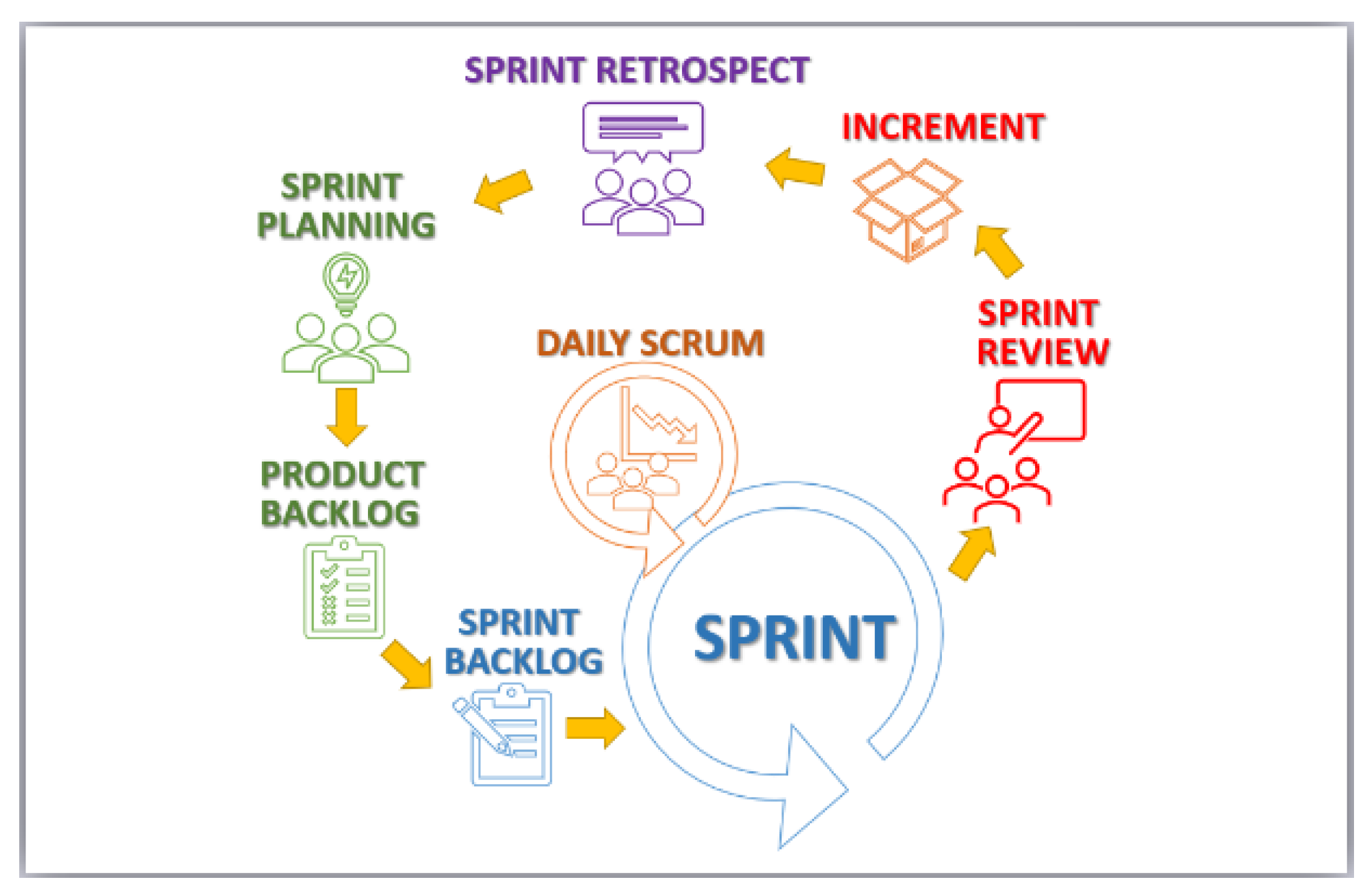
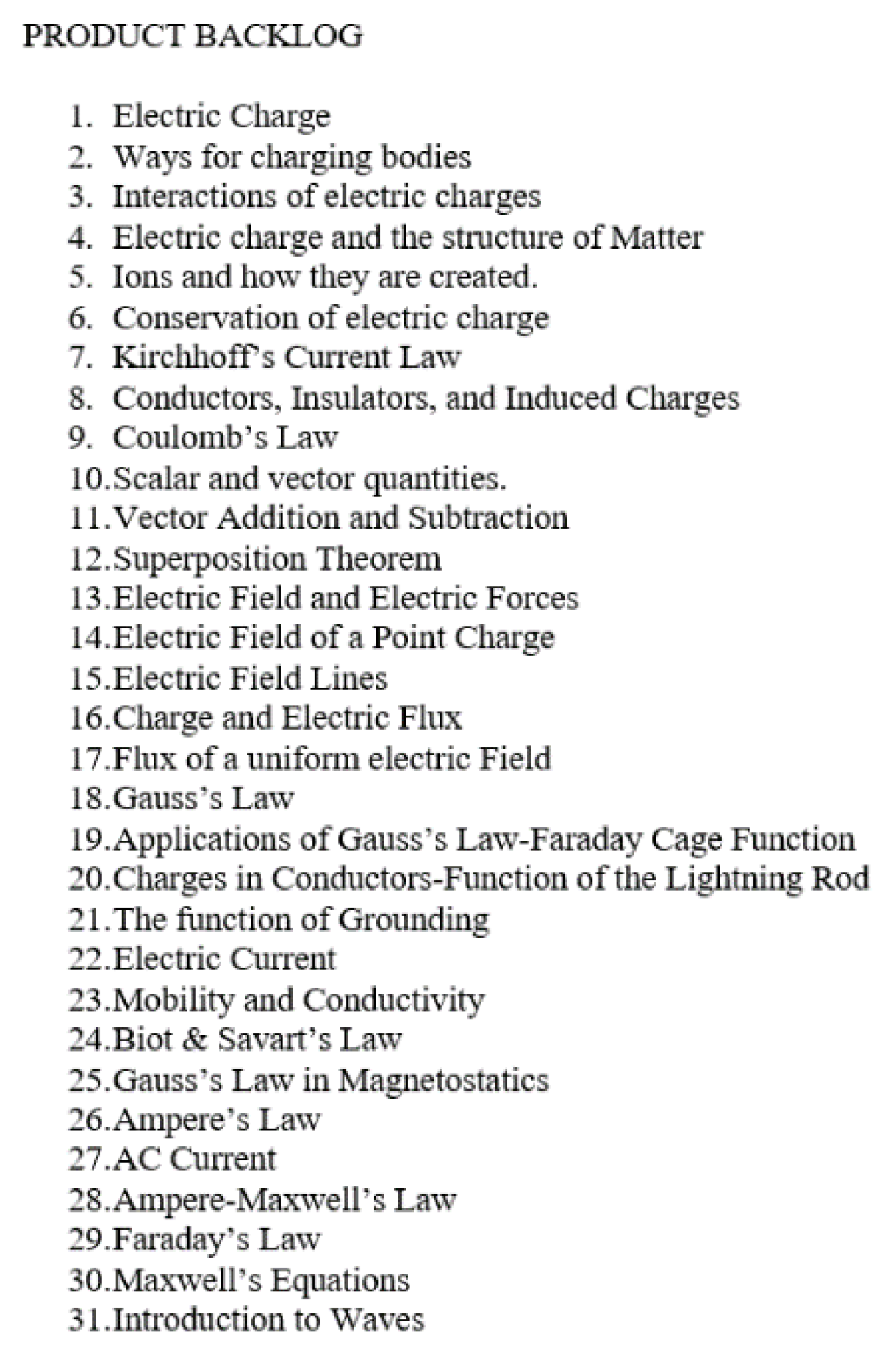
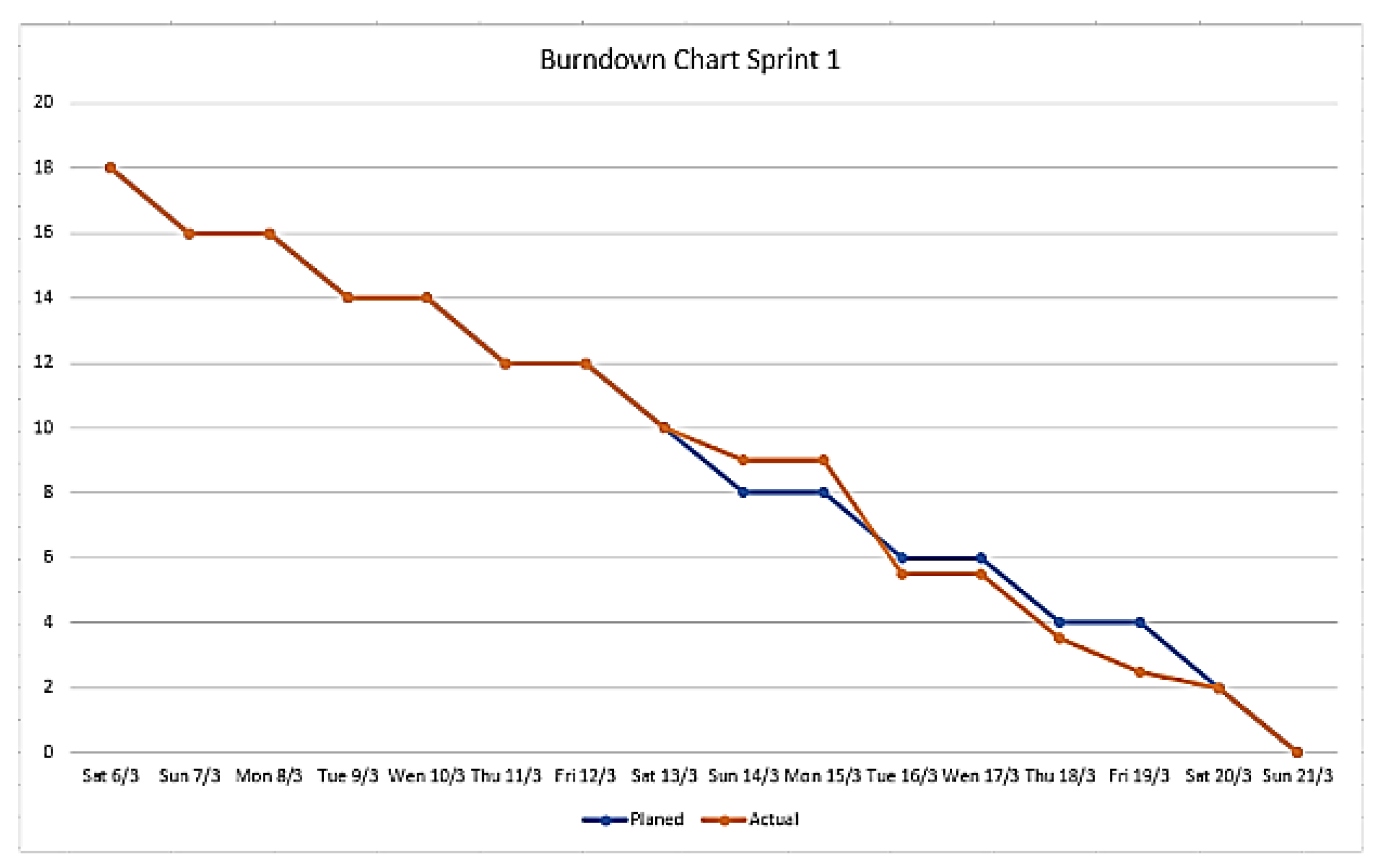
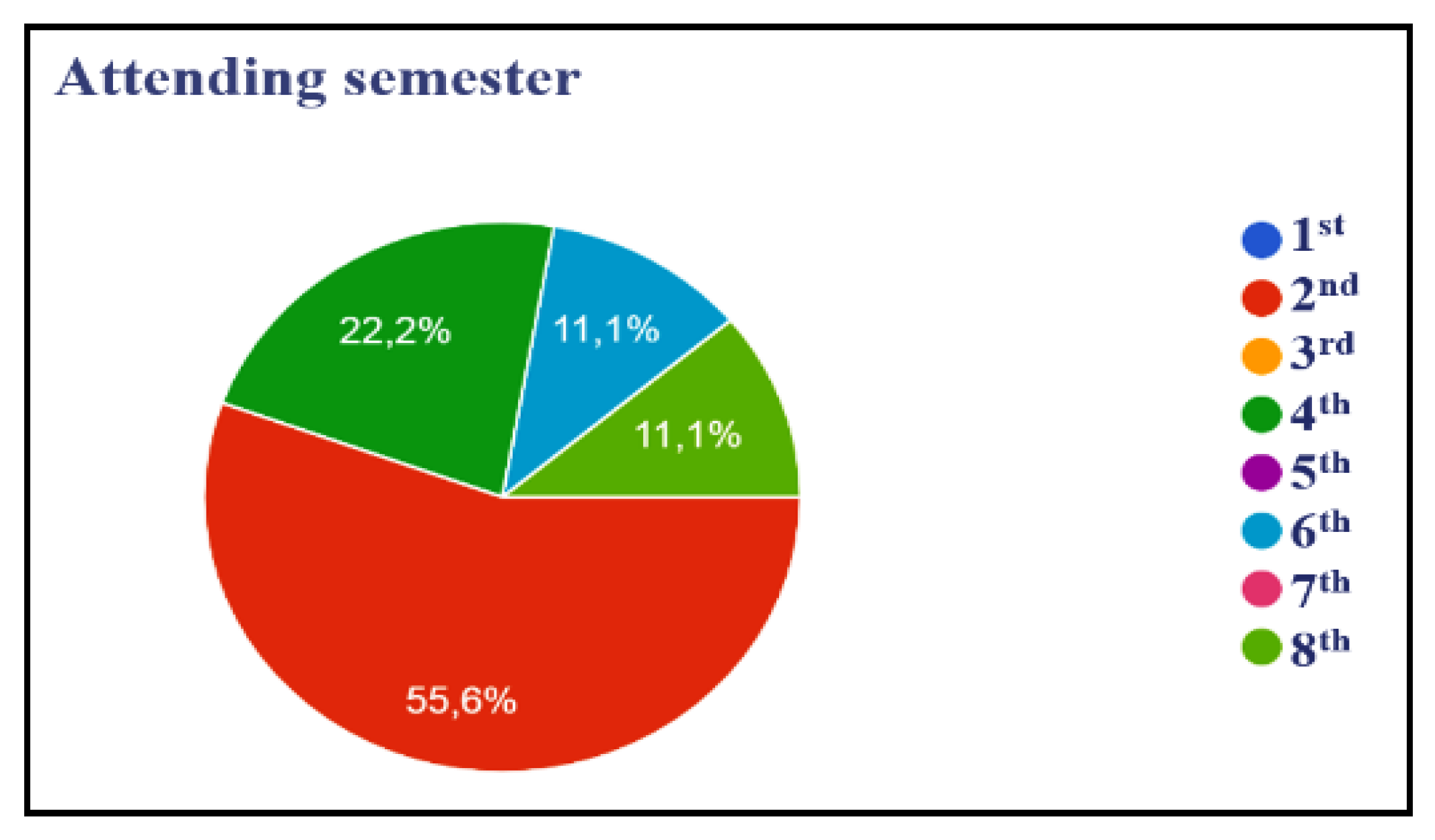
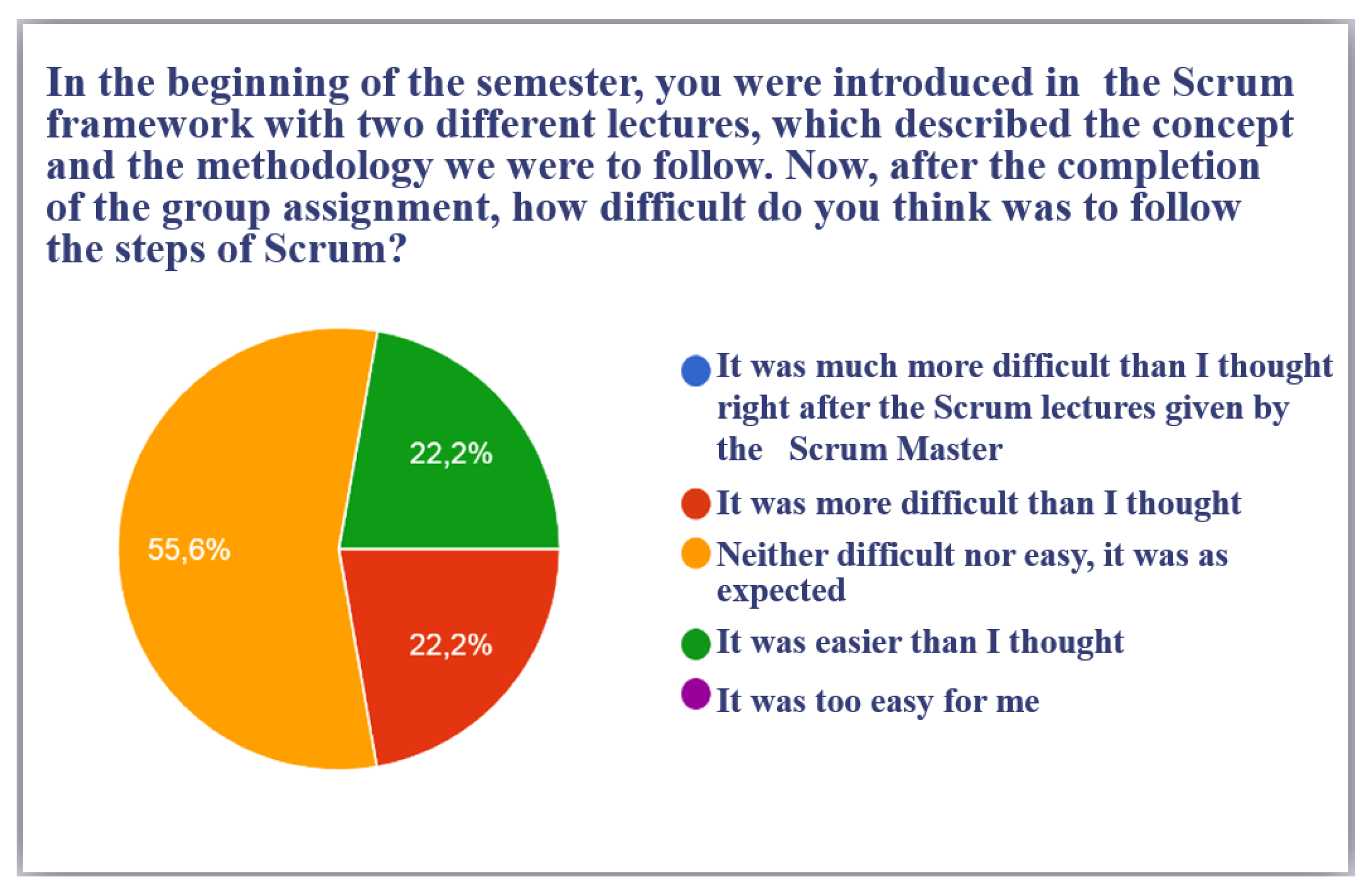
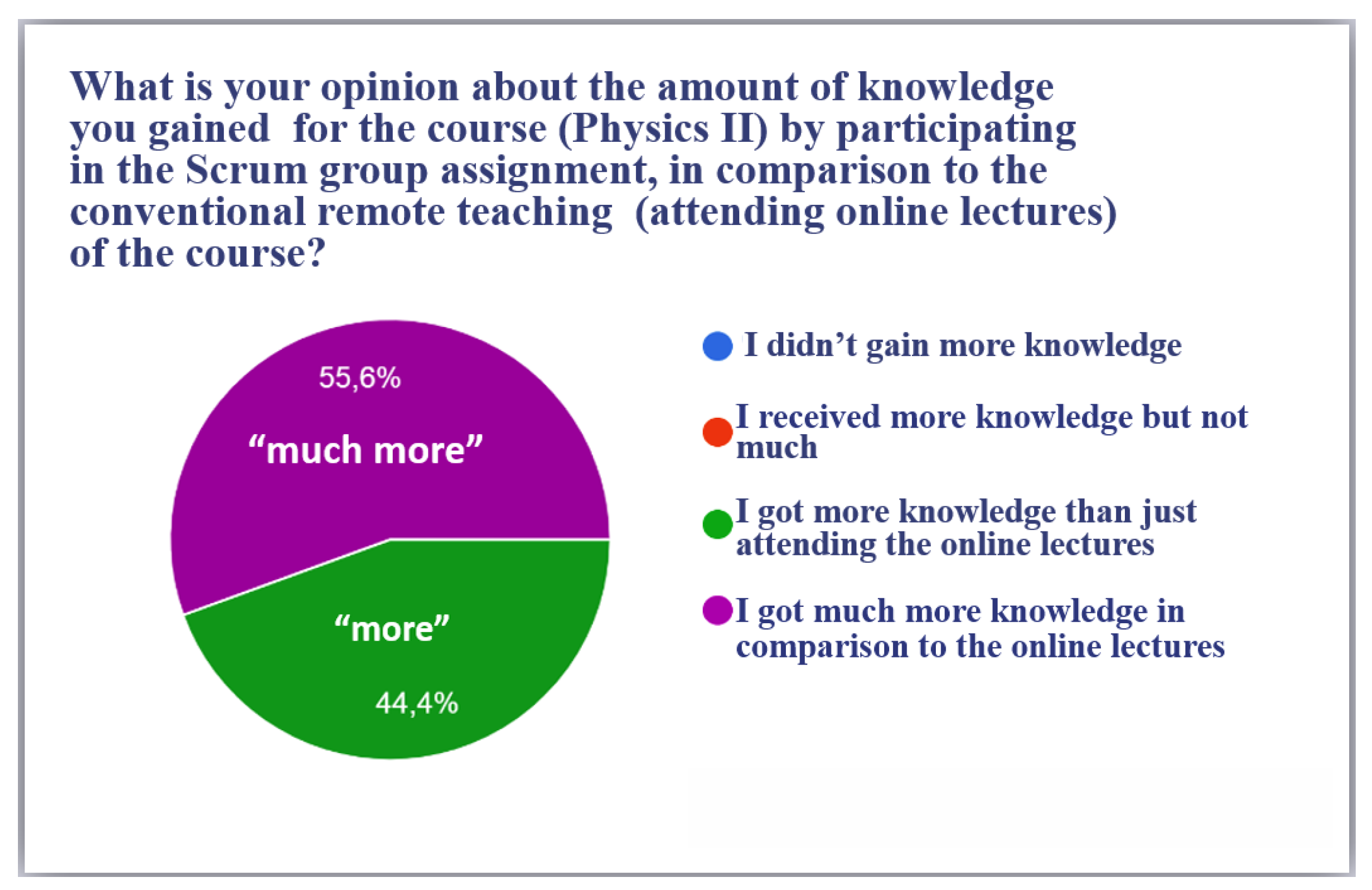
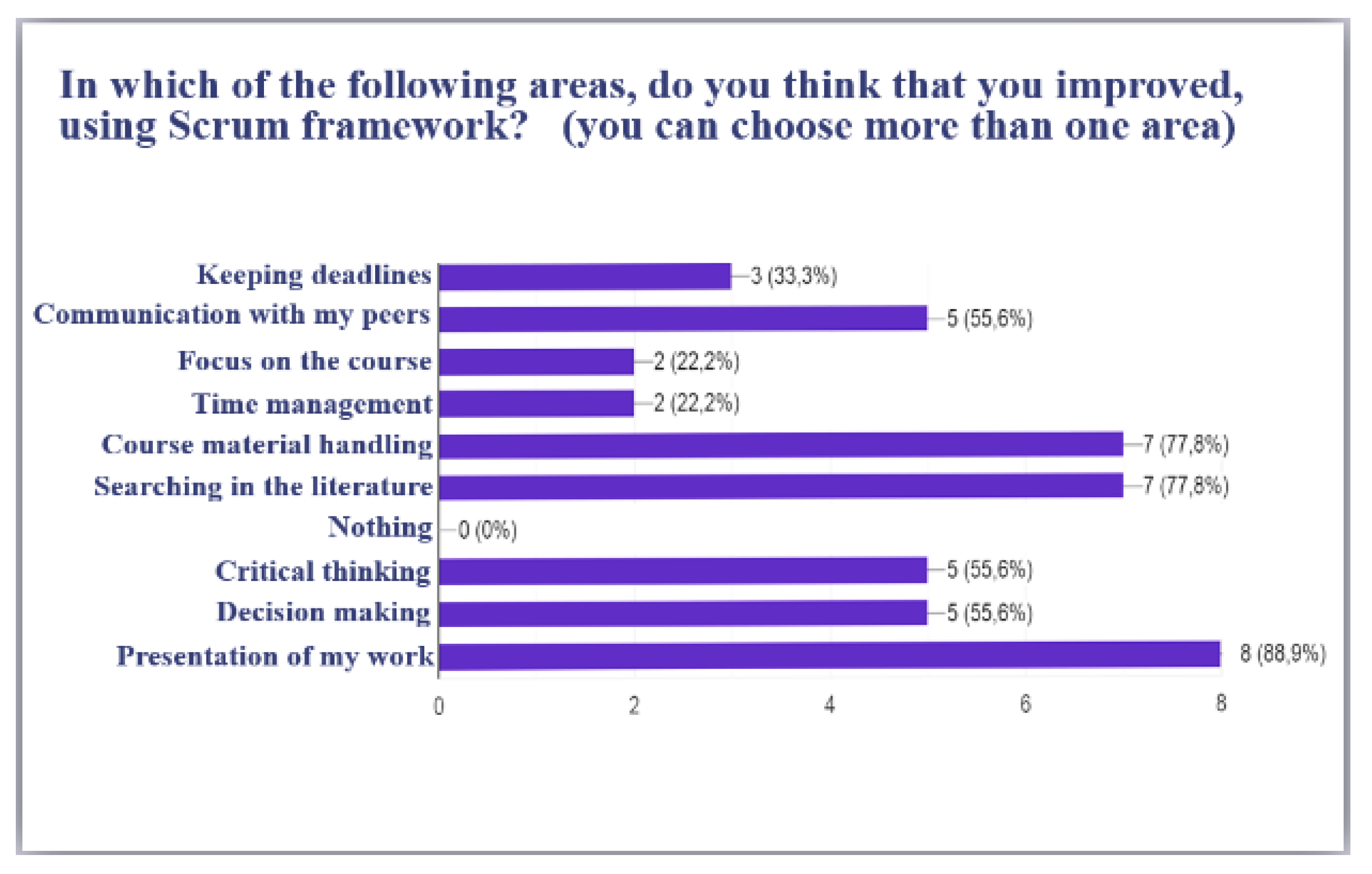
| Sprint | Start Date | End Date |
|---|---|---|
| Sprint 1 | 8 March 2021 | 21 March 2021 |
| Sprint 2 | 26 March 2021 | 9 April 2021 |
| Sprint 3 | 12 April 2021 | 24 April 2021 |
| Team 1 | Team 2 | Team 3 | ||
|---|---|---|---|---|
| Sprint 1 | 30 | 13 | 21 | |
| 1st Phase | Sprint 2 | 35 | 16 | 20 |
| Sprint 3 | 26 | 18 | 20 | |
| Team “Generator” | Team “Full House” | |||
| 2nd Phase | Sprint 1 | 22 | 20 |
| Sprint | Team 1 | Team 2 | Team 3 |
|---|---|---|---|
| 1st | 6 | 5 | 8 |
| 2nd | 5 | 5 | 6 |
| 3rd | 5 | 3 | 5 |
| No SCRUM | SCRUM | |
|---|---|---|
| No. of final exam participants | 92 | 8 |
| No. of participants who passed | 31 | 5 |
| Success rate | 34% | 63% |
| Average final exam grade | 3.8 | 6.7 |
Disclaimer/Publisher’s Note: The statements, opinions and data contained in all publications are solely those of the individual author(s) and contributor(s) and not of MDPI and/or the editor(s). MDPI and/or the editor(s) disclaim responsibility for any injury to people or property resulting from any ideas, methods, instructions or products referred to in the content. |
© 2023 by the authors. Licensee MDPI, Basel, Switzerland. This article is an open access article distributed under the terms and conditions of the Creative Commons Attribution (CC BY) license (https://creativecommons.org/licenses/by/4.0/).
Share and Cite
Lourakis, E.; Petridis, K. Applying Scrum in an Online Physics II Undergraduate Course: Effect on Student Progression and Soft Skills Development. Educ. Sci. 2023, 13, 126. https://doi.org/10.3390/educsci13020126
Lourakis E, Petridis K. Applying Scrum in an Online Physics II Undergraduate Course: Effect on Student Progression and Soft Skills Development. Education Sciences. 2023; 13(2):126. https://doi.org/10.3390/educsci13020126
Chicago/Turabian StyleLourakis, Emmanuel, and Konstantinos Petridis. 2023. "Applying Scrum in an Online Physics II Undergraduate Course: Effect on Student Progression and Soft Skills Development" Education Sciences 13, no. 2: 126. https://doi.org/10.3390/educsci13020126
APA StyleLourakis, E., & Petridis, K. (2023). Applying Scrum in an Online Physics II Undergraduate Course: Effect on Student Progression and Soft Skills Development. Education Sciences, 13(2), 126. https://doi.org/10.3390/educsci13020126






